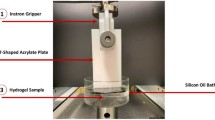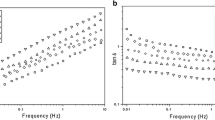Abstract
The problems of vibration and noise have seriously affected people’s production and life. Hydrogel can be used as dam** material because of its good viscoelasticity, but the current dam** material is difficult to meet the needs of actual production and life because of the lack of wide dam** temperature and frequency range and high loss factor. In this work, ammonium persulfate was used as both initiator and oxidant to form a mixed double network hydrogel of polyacrylamide and oxidized sodium alginate. The double network hydrogel prepared by this method has good adhesion and mechanical properties. In addition, due to the adjustable viscoelasticity of the hydrogel, the hydrogel shows excellent dam** properties. When the concentration of MBA is 0.02%, it can reach the temperature range of 0-125 ℃, and the dam** factor is more than 0.3. The visualization experiment proves the practical application effect of the hydrogel, so it is expected to be used as a dam** material in dam**, noise reduction and other fields in the future.










Similar content being viewed by others
Data availability
The data will be available upon request to the corresponding author.
References
** and self-healable ionic elastomer from dynamic phase separation of sticky fluorinated polymers. Adv Mater 35:e2209581
Jia XQ, Li SY, Miu HJ, Yang T, Rao K, Wu DY, Cui BL, Ou JL, Zhu ZC (2020) Carbon nanomaterials: a new sustainable solution to reduce the emerging environmental pollution of turbomachinery noise and vibration. Front Chem 8:683
Zhang W, Ma F, Meng Z, Kong L, Dai Z, Zhao G, Zhu A, Liu XY, Lin N (2021) Green synthesis of waterborne polyurethane for high dam** capacity, macromol. Macromol Chem Phys 222:2000457
Jiang X, Qin R, Wang M, Xu M, Sheng Y, Lu X (2021) Controllable wide temperature range and high dam** polyurethane elastomer based on disulfide bond and dangling chain. Polym Adv Technol 32:2185
Shen L, Ren Z, Xu J, Pan L, Lin Y, Bai H (2022) Dry friction dam** mechanism of flexible microporous metal rubber based on cell group energy dissipation mechanism. Friction 11:259
Xu K, Hu Q, Wang J, Zhou H, Chen J (2019) Towards a stable and high-performance hindered phenol/polymer-based dam** material through structure optimization and dam** mechanism revelation. Polymers 11:884
Liu C, Fan J, Chen Y (2019) Design of regulable chlorobutyl rubber dam** materials with high-dam** value for a wide temperature range. Polym Test 79:106003
Zhao D, Feng M, Zhang L, He B, Chen X, Sun J (2021) Facile synthesis of self-healing and layered sodium alginate/polyacrylamide hydrogel promoted by dynamic hydrogen bond. Carbohydr Polym 256:117580
Shaid Sujon MA, Islam A, Nadimpalli VK (2021) Dam** and sound absorption properties of polymer matrix composites: a review. Polym Test 104:107388
Qi X, ** applications. RSC Adv 9:42367
Zhou J, Li H, Lu X (2018) Dam** elastomer with broad temperature range based on irregular networks containing hyperbranched polyester and dangling chains. Polym Adv Technol 29:2308
Tontiwattanakul K, Sanguansin J, Ratanavaraha V, Sata V, Limkatanyu S, Sukontasukkul P (2021) Effect of viscoelastic polymer on dam** properties of precast concrete panel. Heliyon 7:e06967
Wang F, Liao J, Huang C, Yu H, Yan J, Li H (2022) Study on the dam** dynamics characteristics of a viscoelastic dam** material. Processes 10:635
Jaya Prakash N, Sarkar SS, Kandasubramanian B (2023) Emerging strategies in stimuli-responsive silk architectures. Macromol Biosci 23:e2200573
Bertocchi MJ, Vang P, Balow RB, Wynne JH, Lundin JG (2019) Enhanced mechanical dam** in electrospun polymer fibers with liquid cores: applications to sound dam**. ACS Appl. Polym. Mater. 1:2068
Yuan Z, Ding J, Zhang Y, Huang B, Song Z, Meng X, Ma X, Gong X, Huang Z, Ma S, **ang S, Xu W (2022) Components, mechanisms and applications of stimuli-responsive polymer gels. Eur Polym J 177:111473
Shah LA, Gul K, Ali I, Khan A, Muhammad S, Ullah M, Bibi I, Sultana S (2022) Poly (n-vinyl formamide-co-acrylamide) hydrogels: synthesis, composition and rheologyf. Iran Polym J 31:845
Shou T, Hu S, Wu Y, Tang X, Fu G, Zhao X, Zhang L (2021) Biobased and recyclable polyurethane for room-temperature dam** and three-dimensional printing. ACS Omega 6:30003
Huang S, Kong X, **ong Y, Zhang X, Chen H, Jiang W, Niu Y, Xu W, Ren C (2020) An overview of dynamic covalent bonds in polymer material and their applications. Eur Polym J 141:110094
Zhang H, Li S, Zhang Z, Luo H, Wang Y (2020) A five-parameter fractional derivative temperature spectrum model for polymeric dam** materials. Polym Test 89:106654
Zhou C, Zhao X, **ong Y, Tang Y, Ma X, Tao Q, Sun C, Xu W (2022) A review of etching methods of mXene and applications of MXene conductive hydrogels. Eur Polym J 167:111063
Ma X, Zhou X, Ding J, Huang B, Wang P, Zhao Y, Mu Q, Zhang S, Ren C, Xu W (2022) Hydrogels for underwater adhesion: adhesion mechanism, design strategies and applications. J Mater Chem A 10:11823
Zhou X, Zhao X, Wang Y, Wang P, Jiang X, Song Z, Ding J, Liu G, Li X, Sun W, Xu W (2023) Gel-based strain/pressure sensors for underwater sensing: sensing mechanisms, design strategies and applications. Compos B Eng 255:110631
Geethamma VG, Asaletha R, Kalarikkal N, Thomas S (2014) Vibration and sound dam** in polymers. Resonance 19:821
Patel H, Chen J, Hu Y, Erturk A (2022) Photo-responsive hydrogel-based re-programmable metamaterials. Sci Rep 12:13033
Park B, Shin JH, Ok J, Park S, Jung W, Jeong C, Choy S, Jo YJ, Kim T-i (2022) Cuticular pad-inspired selective frequency damper for nearly dynamic noise-free bioelectronics. Science 376:624
Wu Y, Shah DU, Liu C, Yu Z, Liu J, Ren X, Rowland MJ, Abell C, Ramage MH, Scherman OA (2017) Bioinspired supramolecular fibers drawn from a multiphase self-assembled Hydrogel. Proc Natl Acad Sci USA 114:8163
Sun Z, Li Z, Qu K, Zhang Z, Niu Y, Xu W, Ren C (2021) A review on recent advances in gel adhesion and their potential applications. J Mol Liq 325:115254
Sun M, Qiu J, Lu C, ** S, Zhang G, Sakai E (2020) Multi-sacrificial bonds enhanced double network hydrogel with high toughness, resilience, dam**, and notch-insensitivity. Polymers 12:2263
Li Z, Meng X, Xu W, Zhang S, Ouyang J, Zhang Z, Liu Y, Niu Y, Ma S, Xue Z, Song A, Zhang S, Ren C (2020) Single network double cross-linker (SNDCL) hydrogels with excellent stretchability, self-recovery, adhesion strength, and conductivity for human motion monitoring. Soft Matter 16:7323
Liu D, Yin G, Le X, Chen T (2022) Supramolecular topological hydrogels: from material design to applications. Polym Chem 13:1940
Lin X, Liu Y, Bai A, Cai H, Bai Y, Jiang W, Yang H, Wang X, Yang L, Sun N, Gao H (2019) A viscoelastic adhesive epicardial patch for treating myocardial infarction. Nat Biomed Eng 3:632
Sun M, Qiu J, ** S, Liu W, Sakai E (2020) Visible light induced synthesis of high toughness, self-healing ionic hydrogel and its application in strain sensing. Colloids Surf Physicochem Eng Asp 607:125438
Li Y, Wang H, Niu Y, Ma S, Xue Z, Song A, Zhang S, Xu W, Ren C (2019) Fabrication of CS/SA double-network hydrogel and application in pH‐controllable drug release. ChemistrySelect 4:14036
Gomez CG, Rinaudo M, Villar MA (2007) Oxidation of sodium alginate and characterization of the oxidized derivatives. Carbohydr Polym 67:296
Distler T, Kretzschmar L, Schneidereit D, Girardo S, Goswami R, Friedrich O, Detsch R, Guck J, Boccaccini AR, Budday S (2021) Mechanical properties of cell- and microgel bead-laden oxidized alginate-gelatin hydrogels. Biomater Sci 9:3051
Deepa B, Abraham E, Cordeiro N, Faria M, Primc G, Pottathara Y, Leskovsek M, Gorjanc M, Mozetic M, Thomas S, Pothan LA (2020) Nanofibrils vs nanocrystals bio-nanocomposites based on sodium alginate matrix: an improved-performance study. Heliyon 6:e03266
** S, Li K, **a C, Li J (2019) Sodium alginate-assisted route to antimicrobial biopolymer film combined with aminoclay for enhanced mechanical behaviors. Ind Crops Prod 135:271
Li Y, Wang D, Wen J, Liu J, Zhang D, Li J, Chu H (2021) Ultra-stretchable, variable modulus, shape memory multi-purpose low hysteresis hydrogel derived from solvent‐induced dynamic micelle sea‐island structure. Adv Funct Mater 31:2011259
Dou Y, Wang ZP, He W, Jia T, Liu Z, Sun P, Wen K, Gao E, Zhou X, Hu X, Li J, Fang S, Qian D, Liu Z (2019) Artificial spider silk from ion-doped and twisted core-sheath hydrogel fibres. Nat Commun 10:5293
Ma X, Qu K, Zhao X, Wang Y, Zhang X, Zhang X, Zhou X, Ding J, Wang X, Ma L, Xue Z, Niu Y, Xu W, Wu N, Hao J (2023) Oxidized sodium alginate/polyacrylamide hydrogels adhesive for promoting wheat growth. Int J Biol Macromol 253:127450
Chen T, Chen Y, Rehman HU, Chen Z, Yang Z, Wang M, Li H, Liu H (2018) Ultratough, self-healing, and tissue-adhesive hydrogel for wound dressing. ACS Appl Mater Interfaces 10:33523
Gandhi F, Remillat C, Tomlinson G, Austruy J (2007) Constrained-layer dam** with gradient polymers for effectiveness over broad temperature ranges. AIAA J 45:1885
Yu W, Zhang D, Du M, Zheng Q (2013) Role of graded length side chains up to 18 carbons in length on the dam** behavior of polyurethane/epoxy interpenetrating polymer networks. Eur Polym J 49:1731
Zhao J, Jiang N, Zhang D, He B, Chen X (2020) Study on optimization of dam** performance and dam** temperature range of silicone rubber by polyborosiloxane gel. Polymers 12:1196
Liu S, Wang S, Sang M, Zhou J, Xuan T, Zhang J, Xuan S, Gong X (2023) Hierarchical polyimide-polyborosiloxane host-guest structure with impact resistance, acoustic and thermal insulation performance for electro-stability applications. Chem Eng J 473:145214
Li Y, Zhang J, Li J, Guo S (2024) Design of a broadband composite noise reduction metamaterial with integrated vibration reduction and sound absorption and insulation. Mater Des 238:112709
Funding
National Natural Science Foundation of China (22102067) and Science Fund of Shandong Laboratory of Advanced Materials and Green Manufacturing (Yantai) (AMGM2023F12) and Youth Innovation Technology Support Program of Universities in Shandong Province (2023KJ213).
Author information
Authors and Affiliations
Corresponding authors
Ethics declarations
Conflict of interest
The authors declare no conflicts of interest.
Additional information
Publisher’s Note
Springer Nature remains neutral with regard to jurisdictional claims in published maps and institutional affiliations.
Electronic supplementary material
Below is the link to the electronic supplementary material.
Supplementary Material 1 Movie S1 and S2: The egg dropped from a height of 1 m to a 4 mm thick dam** hydrogel remains intact (MP4).
Supplementary Material 2
Supplementary Material 3 Movie S3 and S4: The egg fell from a height of 1 m to 4 mm thick silica gel and broke (MP4)
Supplementary Material 4
Supplementary Material 5 Movie S5 and S6: The egg fell from a height of 1 m to 4 mm thick leather and broke (MP4)
Supplementary Material 6
Supplementary Material 7 Movie S7-S9: Sound absorption performance of our hydrogels compared with blank group, silicone and leather (MP4).
Supplementary Material 8
Supplementary Material 9
Rights and permissions
Springer Nature or its licensor (e.g. a society or other partner) holds exclusive rights to this article under a publishing agreement with the author(s) or other rightsholder(s); author self-archiving of the accepted manuscript version of this article is solely governed by the terms of such publishing agreement and applicable law.
Received:
Accepted:
Published:
DOI: https://doi.org/10.1007/s10965-024-03913-9




